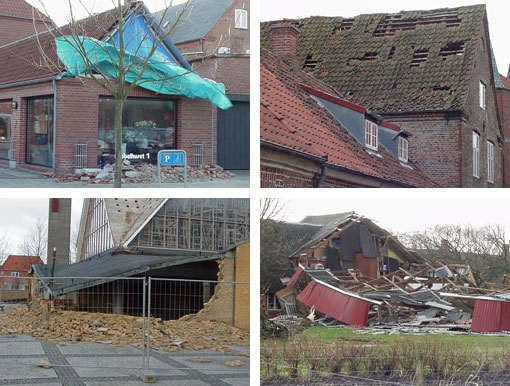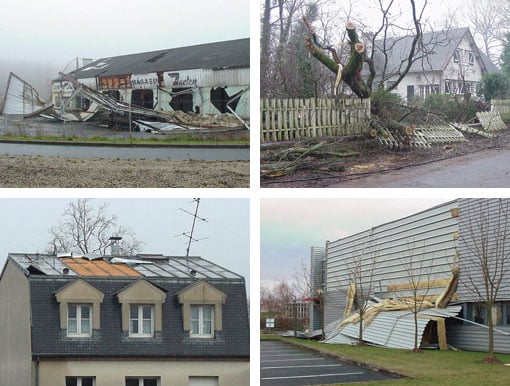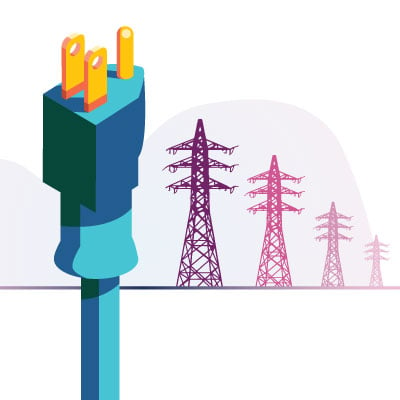
Until Anatol, Lothar, and Martin battered Europe one after another at the end of 1999, a series of destructive European winter storms were thought to be extremely unlikely. The continent had been subjected to a similar series—Daria, Vivian, Wiebke—10 years earlier, but it was considered too soon to expect another. Consequently, the European insurance industry was ill-prepared for the more than EUR 10 billion of insured losses across Europe (in 1999 Euros) these storms caused.
Although no single European winter storm is likely to cause as much damage as an intense Atlantic hurricane striking a major city, their size and ability to travel long distances over land while maintaining their intensity can produce similar total losses. When they come in rapid succession, the cumulative losses can be staggering. Anatol, Lothar, and Martin exhibited just this scenario of lengthy tracks, serial passage—and high insured losses.
Widespread damage
European windstorms typically do not achieve the wind speeds of the most intense tropical cyclones; however, in the course of a single event, an extratropical cyclone system's damaging wind field can affect an area of tens of thousands of square kilometers. And within that large area, specific locations can be subjected to periods of high winds for several days.
Anatol, Lothar, and Martin brought severe damage to 13 countries and seriously impacted others. Europe was affected from the United Kingdom in the west to Russia in the east, from the Scandinavian and Baltic countries in the north, to Spain and Italy—as far as Sicily—in the south.
These storms devastated forests, leveling several times the number of trees as the average annual timber yield in France, Germany, and Switzerland combined. Flooding was reported across southern England, the Netherlands, Belgium, France, Germany, Switzerland, Austria, and Italy. In France, 25% of the country's high-tension transmission lines were lost and 300 high-voltage transmission pylons were toppled. It was one of the greatest energy disruptions ever experience by a modern developed country. In the environs of Paris wind speeds of 215 km/h were recorded atop the Eiffel Tower and an estimated 60% of all roofs were damaged.

Insurance fallout
Because of the scale of the damage and the volume of claims, these three storms revealed several weaknesses in the European insurance industry's ability to respond effectively to such widespread damage. Complications also arose because of the temporal proximity of the storms' passage. And it soon became apparent that the usability and reliability of the data the insurance companies held were inadequate.
The first of the storms, Anatol, had its most destructive impact on Denmark and incurred the country’s largest insured loss ever. The French insurance market was overwhelmed with an estimated 3 million claims filed, mostly from the residential sector.
Anatol, Lothar, and Martin had a significant impact on the reinsurance market, too. In Denmark, Anatol completely exhausted many reinsurance covers. Given the perceived low probability of a loss comparable to severe winter storms Daria, Vivian, and Wiebke in 1990, many insurance companies decided that reinsurance protection up to such unprecedented levels was unnecessary. In Anatol's aftermath, they were hard put to pay out their claims, creating solvency problems.
In France, reinsurance purchasing at the time was based on the losses incurred by the severe winter storms of 1990; however, the wind speeds of Lothar and Martin were nearly 30% higher than those of the earlier storms. Most reinsurance programs were exhausted by Lothar alone.
Reinsurance contracts typically are written to cover a single year, and a multiple-event season can have serious loss implications for a contract. The passage of Lothar and Martin took place in less than 72 hours. Although a standard 72 hours clause was in place for most contracts—which would allow treating the two storms as a single reinsurance recovery—there was no consistent handling of contracts. For reasons of good will, some reinsurers agreed to consider the two storms as separate events (thus enabling insurance companies to receive greater recoveries). Ultimately, reinsurers absorbed more than half of the total insured losses.

A lasting legacy
Rather than causing a limited number of very high claims, European winter storms can generate hundreds of thousands of smaller claims that can add up to significant sums—particularly given the high take-up rates in Europe. These three storms indelibly imposed this awareness on the insurance community and inspired a new sensitivity to the serious Europe-wide repercussions of a phenomenon that previously had been seen largely as local. They prompted increased investigation into the complex nature of extratropical cyclones and their potential to cause damage. They also inspired renewed efforts by the European insurance industry to improve its resilience to this major natural peril.
Using historical losses for risk assessment and management is not sufficient. Thus, companies need to understand and actively manage their risk. The AIR Extratropical Cyclone Model for Europe offers a comprehensive view of year-round risk across 22 countries in Europe. The model captures the meteorological complexities that define the hazard, including storm frequency and storm clustering, as well as inter-annual variability. It also supports 47 construction classes and 117 occupancy classes, as well as a wide range of specialty lines, and explicitly accounts for differences in regional and temporal vulnerability to enable (re)insurers to manage their European windstorm risk.
Do You Know Your European Extratropical Cyclone Risk?



